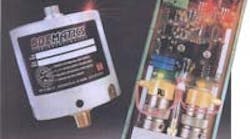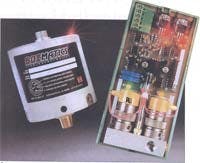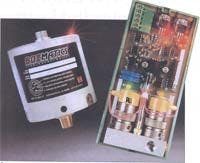Rolls of sheet material—paper, foil, plastic film. etc.—are important ingredients in many packaging processes. When rolling or unrolling such sheet material in high-speed, automated packaging equipment, it is essential that the edges of the material stay aligned precisely to avoid bunching or damage.
The conventional arrangement to align the edges is to pass the material between two unpowered rolls—one with a fixed axis and the second with an axis supported by a pair of identical cylinders. The force distribution along the contact line where the rolls touch is determined by the pressure in the cylinders. With equal pressure at each end, the material passes unhindered between the rolls. If pressure is higher at one end. the material is pulled toward that end. changing its position between the rolls and in etfect. steering it. With a sellsor moniloring edge posilion and a last-response pressure control supplying the cylinders, the edge of the material can be maintained in a very exact location.
While the loads on such edge-guiding eluipment are relatively light, in the past, designers have always used hydraulic systems to get the fast reponse and maintain the stiffness they need. Compressed air was just too spongy tor precision. Modern electronics has changed the picture today. Coupling an electronic air-servo to a pilotoperated regulator provides fast, accurate pressure control with a variety of t’orward and relieving flows.
In the typical pneumatic edge-guiding arrangement diagrammed on the preceding page, supply air is piped through fixed regulator A to the cap ends of both cylinders. Air to the rod end of the passive cylinder flows through fixed regulator B. Supply air flows to the rod end of the steering cylinder through the pilot-operated regulator that is part of the electronic airservo control valve.
The electronic web-po.sition sensor monitors the edge of the material passing through it. Should the edge wander out.side it.s prescribed range, in either direction, the command signal to the servo pressure control changes and the pilot-operated relief valve quickly adjusts the pressure in the rod end of the steering cylinder up or down to change the applied force and bring the web back into its specified position.
Buz Lewis. president Buzmatics, Inc. Indianapolis, described this application and control circuit.



